Taking time at the beginning of the year to carefully introduce Math Workshop empowers your students to take ownership of their daily math routines, and makes it easier for them to develop self-directed learning skills. In this series of posts, I will be sharing details for how I introduce Math Workshop to my students during the first weeks of school each year.
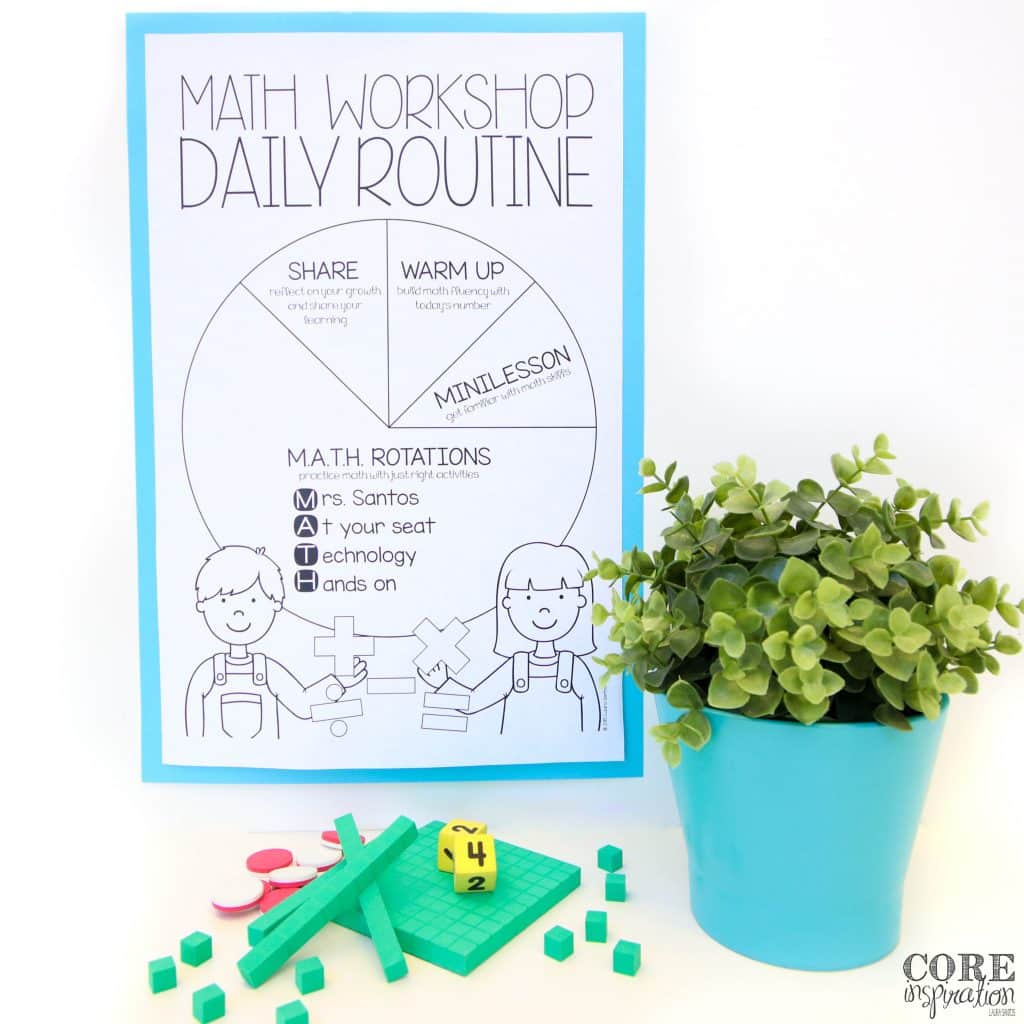
BACKGROUND ABOUT MATH WORKSHOP IN MY CLASSROOM
If you have not already read my posts about the structure of Math Workshop, I encourage you to start here so you have a detailed understanding of each component of workshop. Here is a quick refresher on how I use this guided math structure.
We use Math Workshop four days a week in our third grade classroom. On Fridays, we do not have workshop simply because we have specials that occur during our math time. Although I only teach math four days a week, I am able to teach all the content standards throughout the year without feeling rushed.
On Monday-Thursday during Math Workshop, our schedule looks like this:
- 8:30 – 8:50 Math Warm Up (Number of the Day Binder)
- 8:50 – 9:10 Morning Meeting (a little break in our workshop schedule)
- 9:10 – 9:20 Math Mini Lesson
- 9:20 – 9:42 M.A.T.H. Rotation 1
- 9:43 – 10:05 M.A.T.H. Rotation 2
- 10:05 – 10:10 Share
Since we only have time for two M.A.T.H. rotations per day, students are always scheduled to complete the at your seat rotation daily, and alternate back and forth between hands on and technology every other day. Here’s a detailed look at our weekly schedule.
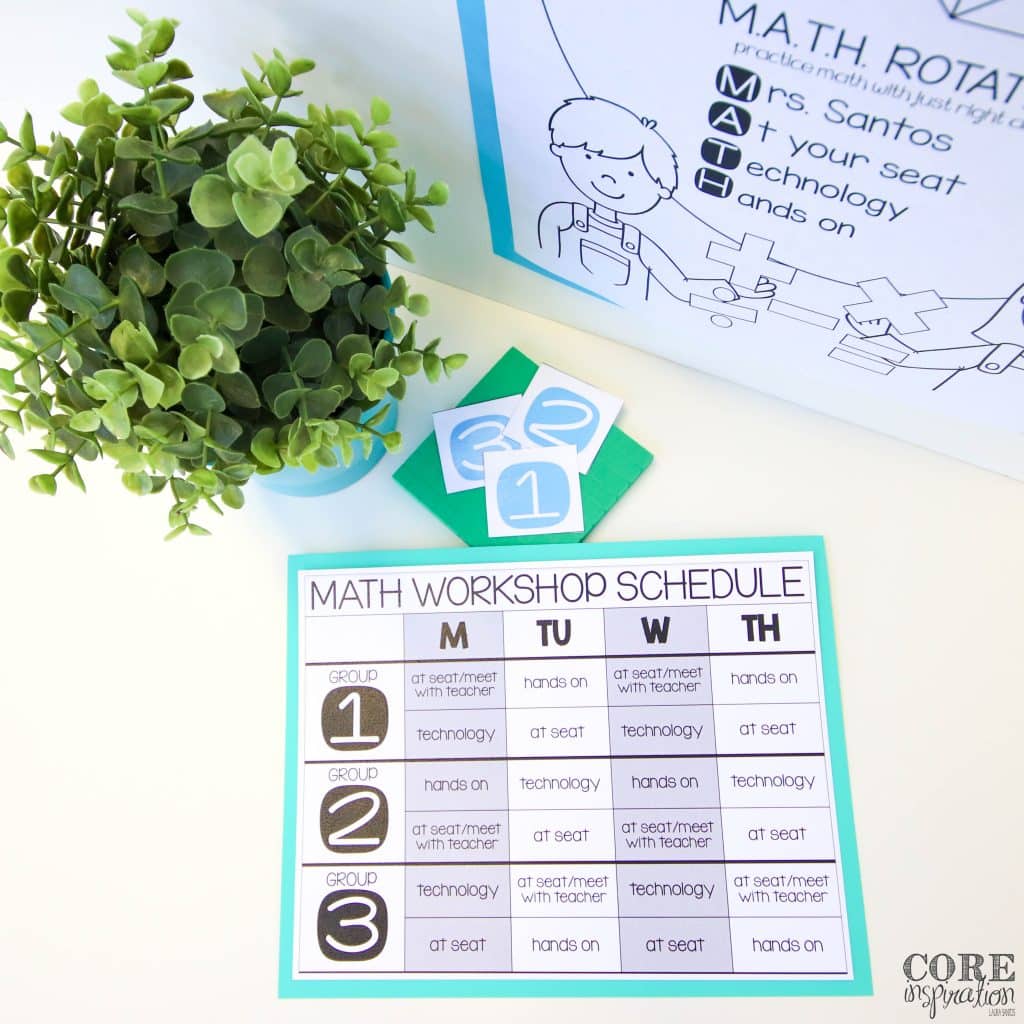
THE FIRST WEEK OF MATH WORKSHOP
Now that you have a bit of background, let’s focus in on how I introduce workshop to my third graders at the beginning of the school year. I hold off on introducing Math Workshop until the second week of school because I like to spend the first week introducing classroom routines, and building a foundation for respect in our class community. The following Monday, the first week of Math Workshop begins. My goals for this first week are completely focused on the warm up, mini lesson, and at your seat rotation of workshop. These goals include:
- Familiarize students with the overarching structure of workshop.
- Support students toward independently working through our daily math warm-up.
- Support students in becoming active participants during our daily mini lessons.
- Support students toward independently working through the routines required for the at your seat rotation of workshop.
To accomplish these goals, I slowly and carefully introduce the warm up, mini lesson, and at your seat routines and expectations throughout the week.
DAY 1: INTRODUCTION, MATH MINI LESSON EXPECTATIONS, AND TRANSITIONING TO AT YOUR SEAT ROTATION
The first day of Math Workshop is focused on introducing the structure of workshop, modeling expectations for math mini lessons, and modeling expectations for transitioning to the at your seat rotation after a mini lesson. Here’s how I like to introduce these routines:
Introduction
- Introduce the structure of Math Workshop, and very briefly talk through each component using the pie chart as a visual.
Mini Lesson Expectations
- Model expectations for coming to the carpet for a mini lesson: students bring their whiteboard supplies and pick a spot in front of the front whiteboard where they can focus. I like having them come to the carpet because it makes it easier for me to measure their understanding and misconceptions during the mini lesson.
- Teach the first mini lesson of the year. This is an actual content lesson based on our math curriculum (we currently use EnVision Common Core CA, so I teach lesson 1-1). During this mini lesson, I model how to use the whiteboard for creating math models, how to circle the solution, and how to hold the board in the air to show understanding/progress throughout the lesson. Students also learn that the whiteboard is used as a tool for learning. If they cannot handle the responsibility of using a whiteboard, and make the decision to draw or play with the board, they lose their whiteboard privilege for the week, and have to solve with paper and pencil instead.
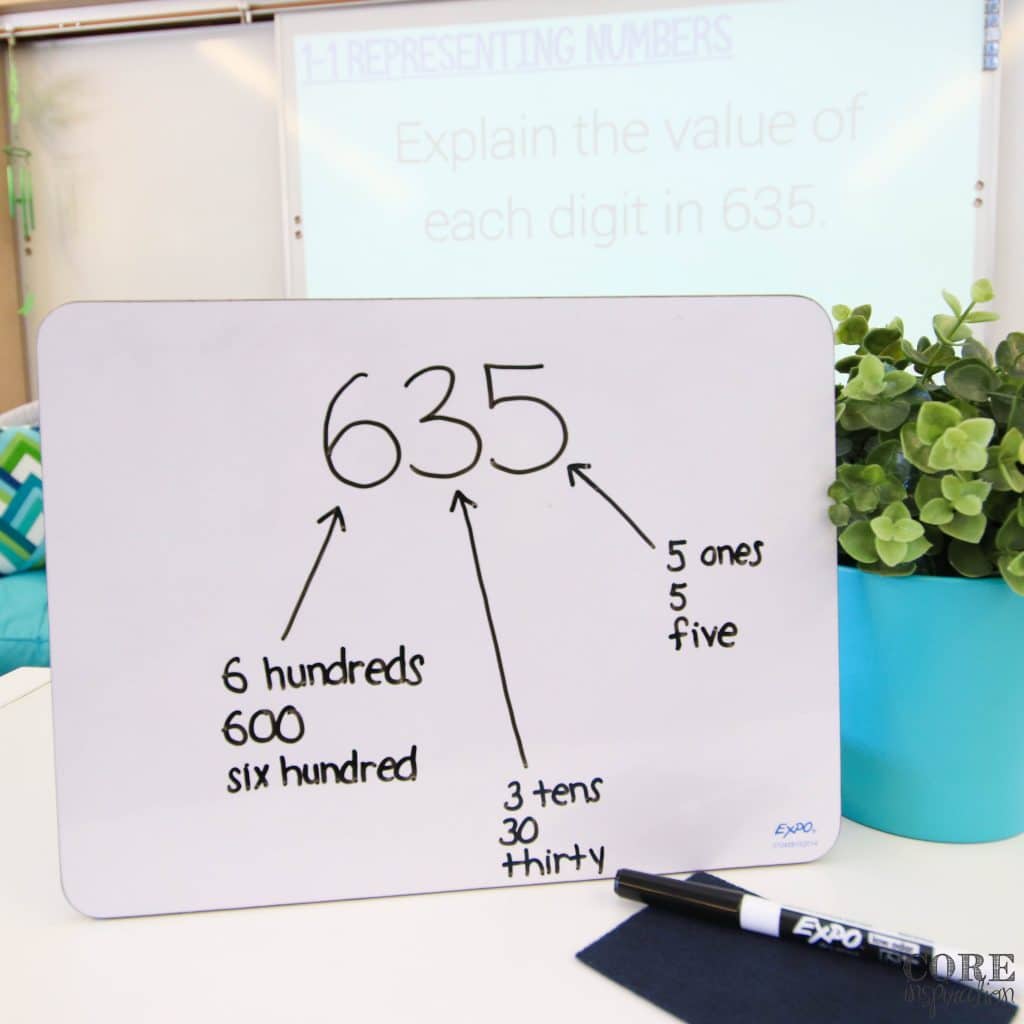
At Your Seat Rotation Transitions
- Model how to transition from the mini lesson space to their seat to begin working on their first at your seat assignment. This transition includes leaving the carpet with whiteboard supplies, tucking whiteboard supplies away in their desk, taking out their math workbook (we use the EnVision Practice Book), tearing out the reteach page that corresponds with the day’s lesson (the page is always written on the board next to our Math Workshop Routine Pie Chart), tucking the workbook away, and beginning their reteach page. For now, students are asked to work at their actual desk for the at your seat rotation. Once they demonstrate mastery of this routine, they will have the flexibility to work in other areas of the room, and use lap desks, clipboards, or counter space if they are more comfortable working away from their desk.
- Model how to have worked checked. Once everyone is settled in and working on their reteach page, I call for the students’ attention and model what to do when they complete the reteach page. For the first week or two as we are working toward mastering the at your seat routine, I personally check each reteach page. My students tap their head to signal they are done with their work, and ready to have it checked. Once I have checked their work, they tuck the page in their homework folder – the back side of the page has their homework problems. Later in the year, students will use the Computation Check flap to check their work independently. Under this flap will be an answer key that allows them to independently check their work.
Pacing The Roll-Out of Routines
Usually at this point in the at your seat routine, students would move from their quick reteach page into the enrichment choices like task cards or project based learning. I hold off on introducing all these options on the first day because I don’t want to overwhelm students with information, or take away from their ability to grasp the routines I have already introduced on day one.
I do want them to get a feel for the duration of math workshop, so rather than ending early, I have students take a short math pre-assessment from our EnVision curriculum to demonstrate their retention of second grade math concepts. Usually, only a few students finish this short assessment before it’s time for math workshop to end, so I collect their progress and have them finish it the following day.
We end day one by coming together and reviewing the routines introduced while referring to the pie chart visual.
DAY 2: WARM-UP ROUTINE AND PROBLEM SOLVING TASK CARD TOUR
Day two builds on the routines introduced during Day 1 with the introduction of the warm-up routine, and a first look at expectations for using task cards during the at your seat rotation. The details for day two are as follows:
Warm-Up Routine Introduction
- Introduce the warm-up routine. Model how to take the binder out of the desk, find the number of the day on the board next to the schedule, work through the activities on the first page of the binder, then tap your head to signal you are ready to have your work checked for accuracy before tucking it away in your desk. I then leave the model on display, change the number, and have my third graders work through this routine independently. Students know to book shop in our classroom library or read silently if they finish while others are still focusing.
Mini Lesson Expectation Review
- Teach the second mini lesson of the year. During this mini lesson, I continue to model how to use the whiteboard for creating math models, how to circle the solution, and how to hold the board in the air to show their understanding/progress. I also show them how to add labels to their math models using math vocabulary from the lesson.
At Your Seat Routine Review
- Model how to transition from the mini lesson space to their seat to begin working on their at your seat assignment using the same steps as day one. Students are dismissed in small groups to demonstrate their progress toward mastering this transition. As the first group executes the routine, the rest of us watch, and I share a think aloud about what I notice they are doing responsibly. Other groups are dismissed to join them.
- Monitor student progress toward independently working through the at your seat routine, and share noticings as students work. I am still not meeting with any small groups at this point, I am only focused on student behavior and progress toward mastering this detailed routine.
- Check student work. Students complete their reteach page, have it checked, and tuck it in their homework folder, then work on an addition and subtraction fact fluency page while others focus on finishing their reteach page.
Problem Solving Task Card Tour
- Introduce the task card board. Once everyone is finished with their reteach page, I call them together and collect the progress they’ve made on the fact fluency page so I can introduce our first at your seat enrichment choice: task cards. During this first lesson on task cards, I only focus on task card etiquette, and the layout of our task card board (Making Meaning Tasks are multi-step word problems that are closely aligned to the lesson for that week, Challenge Tasks take a skill introduced during our mini lessons, and use it as a starting point for more complex problem solving that reaches deeper into, or beyond our third grade standards). Students learn to quickly select a task card from the pocket, grab a recording sheet from the drawer, and head to their seat to begin. On day two, I do not model how to complete a task card, as this will be the first part of workshop on day three.
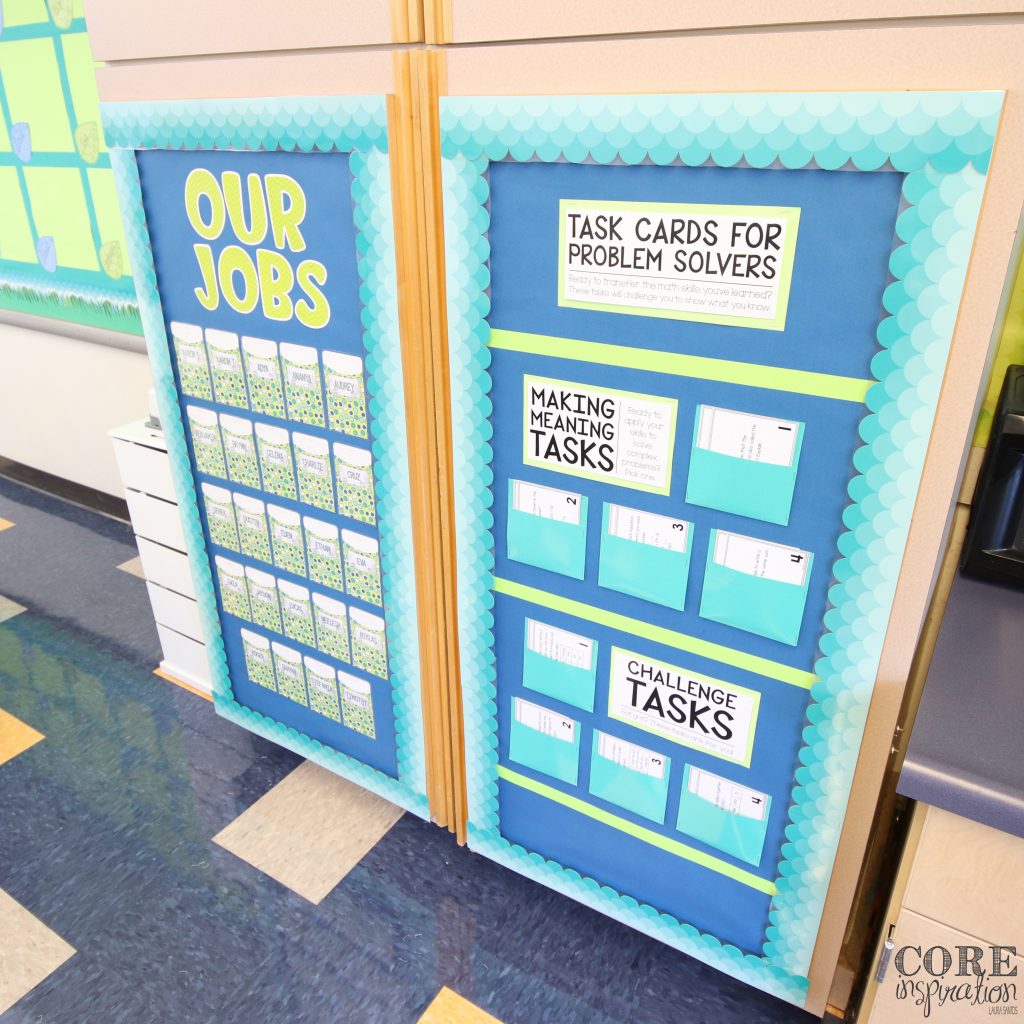
After answering questions related to the task card board layout, we come together and review the routine introduced while referring to the pie chart visual.
DAY 3: PROBLEM SOLVING TASK CARD ROUTINE
In my classroom, the third day of math workshop includes a lot of modeling and direct instruction compared to the other days of the first week because we learn how to solve a math problem solving task card using detailed math models. Here’s how I approach day three of workshop:
Warm-Up Routine Review
- Support students as needed during the warm up routine. Depending on the independence of the unique groups I teach from year to year, I sometimes find the need to model the warm up routine for a second day. This year, I was able to display a warm up checklist on the board, and my students worked through this checklist with an impressive level of independence.
- Create a routine checklist together as a class. I call my students to the carpet so we can create a list of all the steps we have learned about the mini lesson and at your seat routine thus far. We will use this checklist to help us keep track of all the steps we’ve learned over the next couple days. Some of my students who require more scaffolding for detailed routines will also use this checklist on a daily basis throughout the year.
Problem Solving Task Card Routine Introduction
- Teach the full task card routine before the mini lesson. I like to teach this routine before starting the mini lesson for the day so students can work through the entire at your seat routine for the first time. I begin by reviewing the task card expectations introduced on day two (select a task, grab a recording sheet, head to your desk and begin solving). Then I have students practice getting a recording sheet from our storage drawer, and head to their seat to follow along as I model how to use the sheet as a tool for completing a task card in detail. During this modeling session, we work through the problem solving steps listed on the side of the recording sheet to create a model task card, which each student will store in the back cover of their math workshop binder for future reference. After our model is tucked into our binder, we add the steps for completing a task card to our routine checklist.
- Enjoy a short brain break. Considering the fact students have been listening and working from the board for quite some time, I like to give them a brain break before we jump into the mini lesson for the day.
Mini Lesson Expectation Review
- Begin the mini lesson. During this mini lesson, I continue to model how to use the whiteboard for creating math models, how to circle the solution, how to add detail and labels to math models, and how to hold the board in the air to show their understanding/progress. I point out that the steps we use to solve problems during our mini lesson are very similar to those use to create models when solving task cards.
At Your Seat Routine Review
- Monitor student progress toward independently working through the at your seat routine and share noticings as students work. Once again, I am not meeting with any small groups at this point, I am only focused on student behavior and progress toward mastering this detailed routine. The routine checklist we created together as a class is on display during this time to support independence.
We end day one by coming together and reviewing the routines introduced while referring to the pie chart visual.
DAY 4: RUBRIC DRAWER TOUR AND ROUTINE FOR SUBMITTING COMPLETED PROBLEM SOLVING TASKS
Day 4 is when the magic starts to happen. After slowly introducing several of the steps required for students to work through the at your seat rotation independently, you get to see what they’ve learned come together. Compared to the first three days, you will likely feel more freed up as your students begin to show the first signs of at your seat mastery.
Warm-Up Routine Review
- Support students as needed during the warm up routine. I display our warm up checklist to continue fostering self-directed learning.
- Review the routine checklist you’ve created together. Before coming to the carpet, I display the checklist for the mini lesson and at your seat routine we’ve been building together over the first few days of workshop. I let students know they are likely to finish a task card today. When they do, they should place it on the corner of their desk, and immediately begin a second task. I also let students know I will introduce the routine for turning in completed tasks at the end of workshop today.
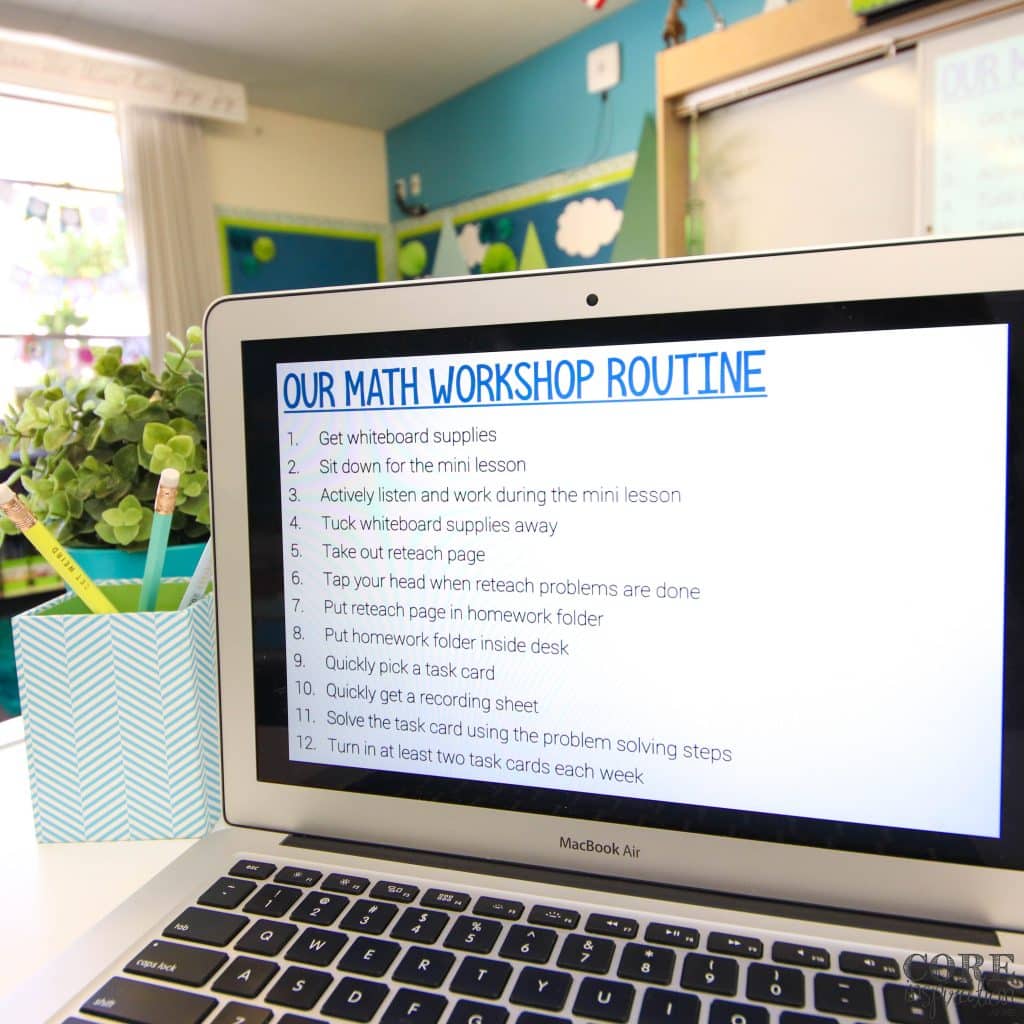
Mini Lesson Expectation Review
- Begin the mini lesson. During this mini lesson, I continue to model how to use the whiteboard for creating math models, how to circle the solution, how to add detail and labels to math models, and how to hold the board in the air to show their understanding/progress. Once again, I point out that the steps we use to solve problems during our mini lesson are very similar to those used to create models when solving task cards.
At Your Seat Routine Review
- Monitor student progress toward independently working through the at your seat routine and share noticings as students work. Once again, I am not meeting with any small groups at this point, I am only focused on student behavior and progress toward mastering this detailed routine. The routine checklist we created together as a class is on display during this time to support independence.
Rubric Drawer Introduction
- Introduce the rubric drawers. I call my students down to the carpet to get a close look at our rubric drawer tower. I begin by pointing out the mastery scale shown on the drawers, then explain what each level is called and what it means to be performing at that level of mastery. The description for each level was created by my class three years ago and is written in student-friendly language. Students will use these drawers to score their level of understanding for each task card they complete during workshop each week.
- Introduce routine for submitting completed task cards to the rubric drawers. I then teach students that each week, they are required to submit at least two completed task cards. Once they complete a task, they will walk over to the rubric drawers, reflect on their level of understanding for that task, and place their recording sheet in the drawer that corresponds with that level of understanding. Any task submitted to these drawers will be very quickly checked by me, stamped, and sent home in the weekly work folders so their parents can see their work. Each week, they get to select one of their tasks to submit to the top bin. This task will be closely checked by me, scored, entered in the gradebook, and given written feedback before bring sent home in the weekly work folder so their parents can see their score.
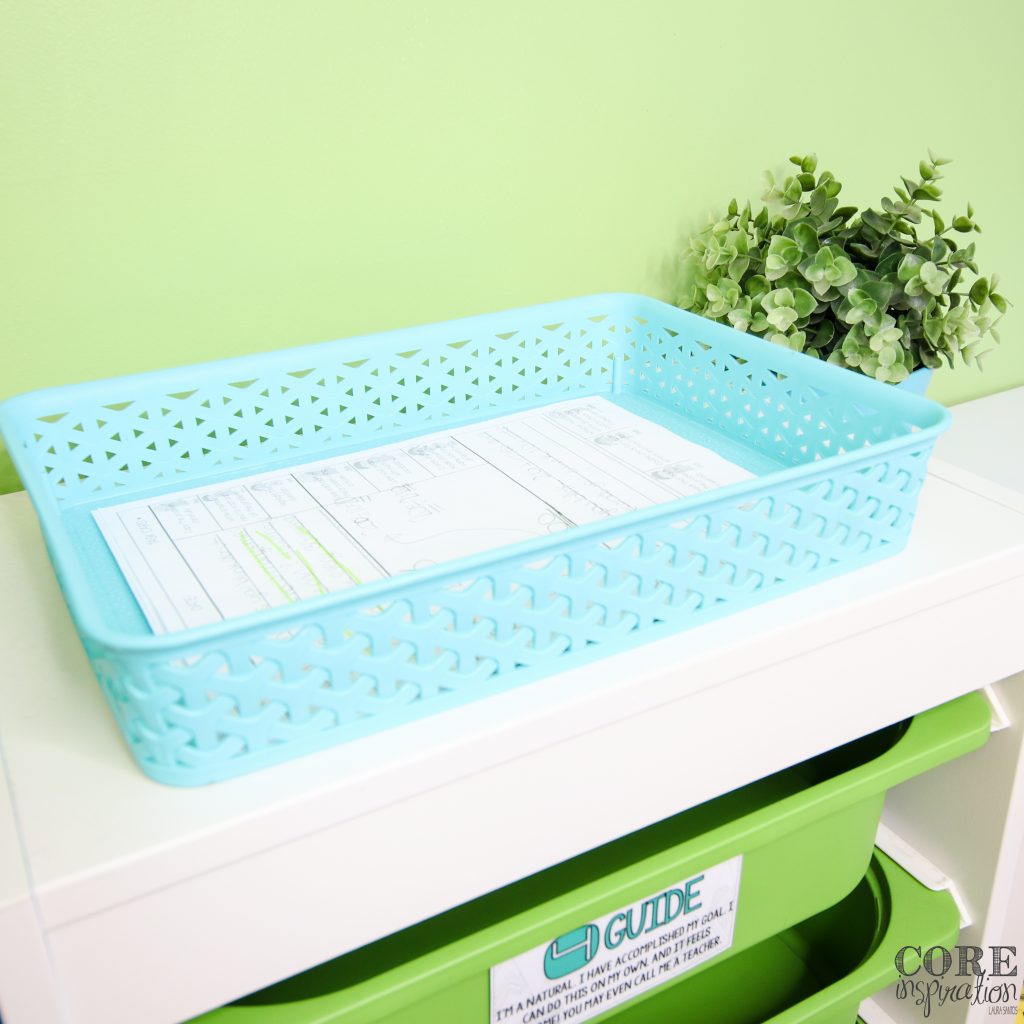
- Give students time to work and submit task cards. After answering any questions related to our rubric drawer system, students are given five more minutes to work at their seat, and submit any tasks that are already complete.
We end day one by coming together and reviewing the routines introduced while referring to the pie chart visual and celebrate the culmination of our first week of Math Workshop.
INTRODUCING MATH WORKSHOP IN YOUR CLASSROOM
As you can see from this overview, I carefully introduce the detailed routines of Math Workshop at a gradual pace. I find taking the time to model each routine, observing student progress toward mastering routines, and then building on those routines empowers students to develop self-directed learning skills.
When I know with confidence that my students are independently working through their M.A.T.H. rotations, I can carefully focus my attention on the working closely with students to meet their unique needs once workshop is up and running smoothly. Taking it slow at the beginning allows us to move at a more efficient pace for the rest of the year.
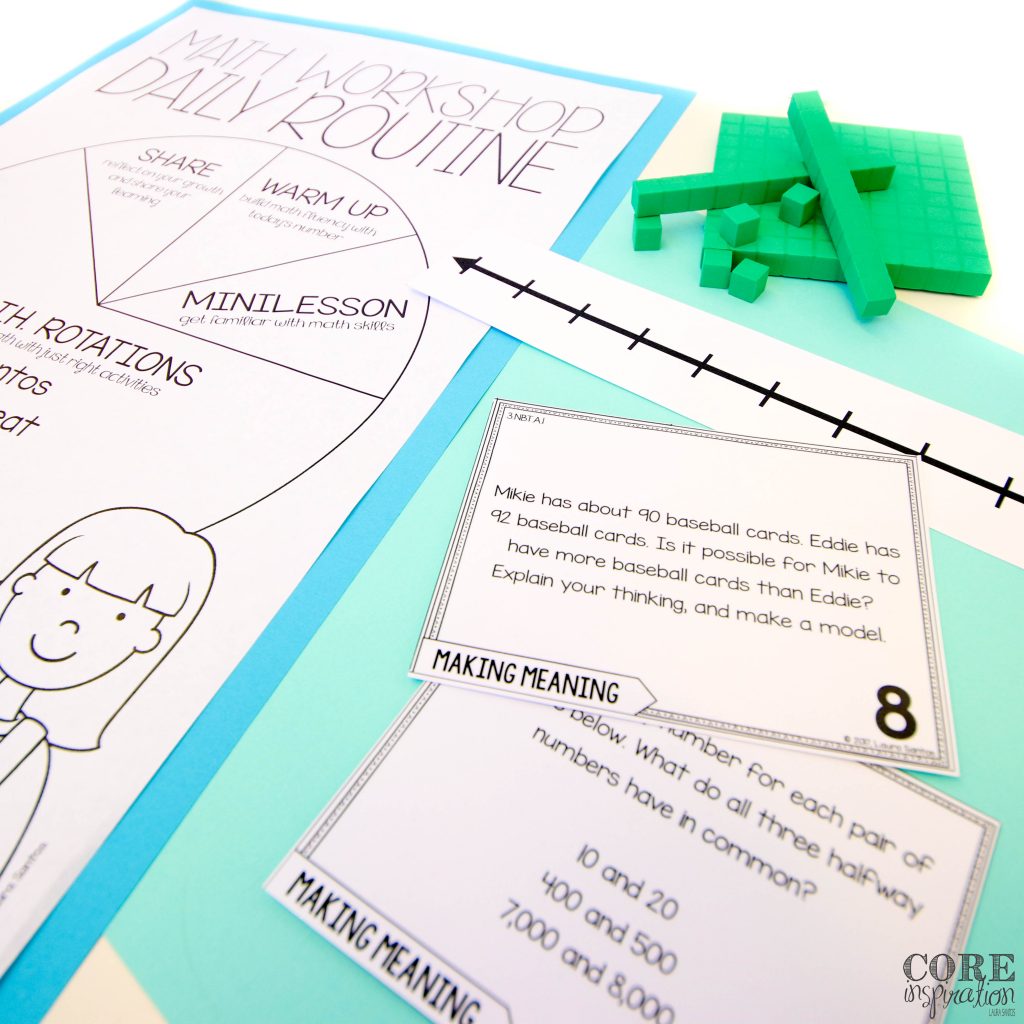
If you have any questions about our first week of Math Workshop, or want to share your approach for introducing workshop during the first weeks of school, please comment below.
INTERESTED IN LEARNING MORE?
For more details about Math Workshop, check out my other posts about this instructional approach.
HOW TO INTRODUCE MATH WORKSHOP IN YOUR CLASSROOM:
DETAILS ABOUT M.A.T.H. ROTATIONS:
- Overview: Differentiate Instruction with Math Workshop
- Warm Up: Number of the Day Binder
- Mini Lesson: 3 Approaches To Formatting Lessons for Math Workshop
- Meet with the Teacher: How To Organize Small Groups for Math Workshop
- Meet with the Teacher: 5 Steps To Efficient Data Tracking
- At Your Seat: Top 5 Ideas for Math Workshop At Your Seat
- At Your Seat: Boost Problem Solving Skills
- Hands On: Tips for Making Math Games A Success
MATH WORKSHOP CLASSROOM MANAGEMENT TIPS:
- How To Boost Student Independence With Math Triads
- Incorporating Project Based Learning Into Math Workshop
- How To Make Transitions Efficient During Math Workshop
READY TO GIVE MATH WORKSHOP A TRY?
If you want to give Math Workshop a test drive in your own classroom, grab your Math Workshop Starter Kit, and feel free to share any questions you have about implementation in the comments below.


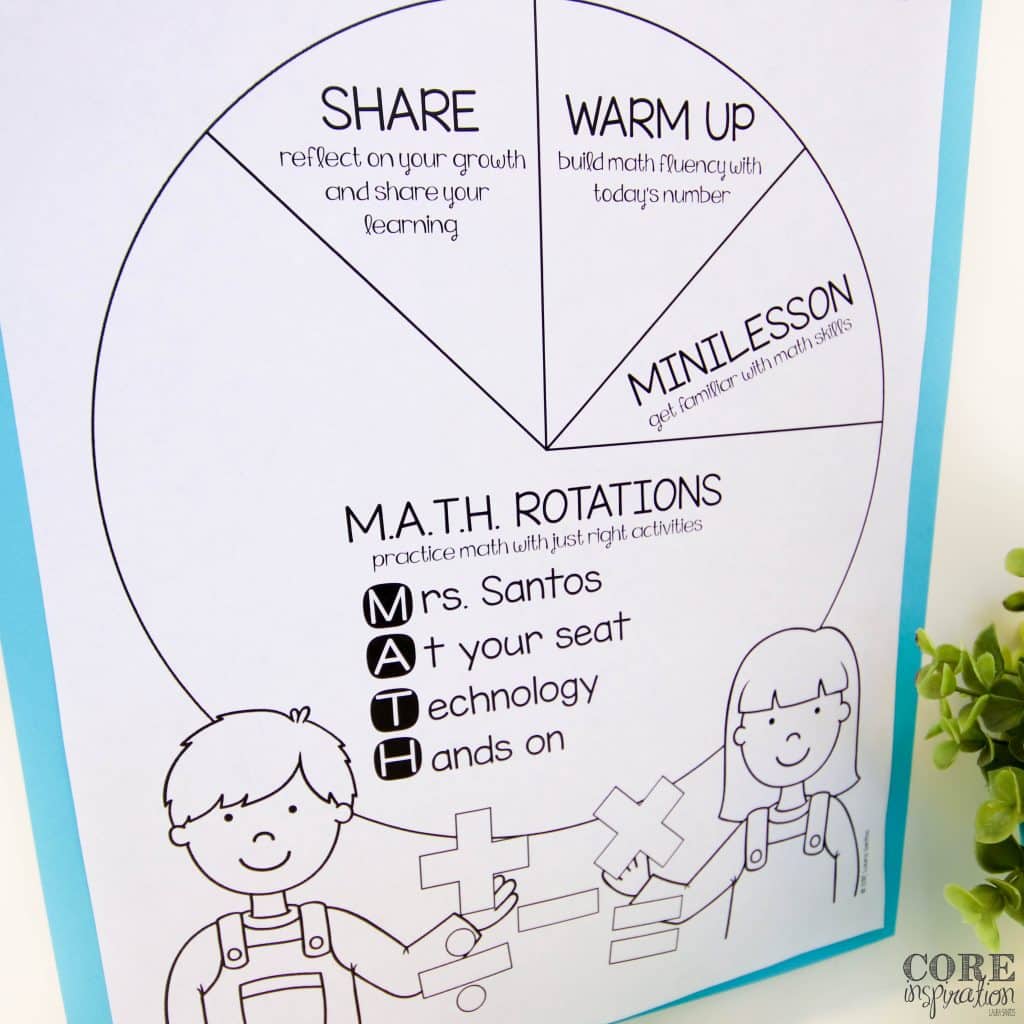
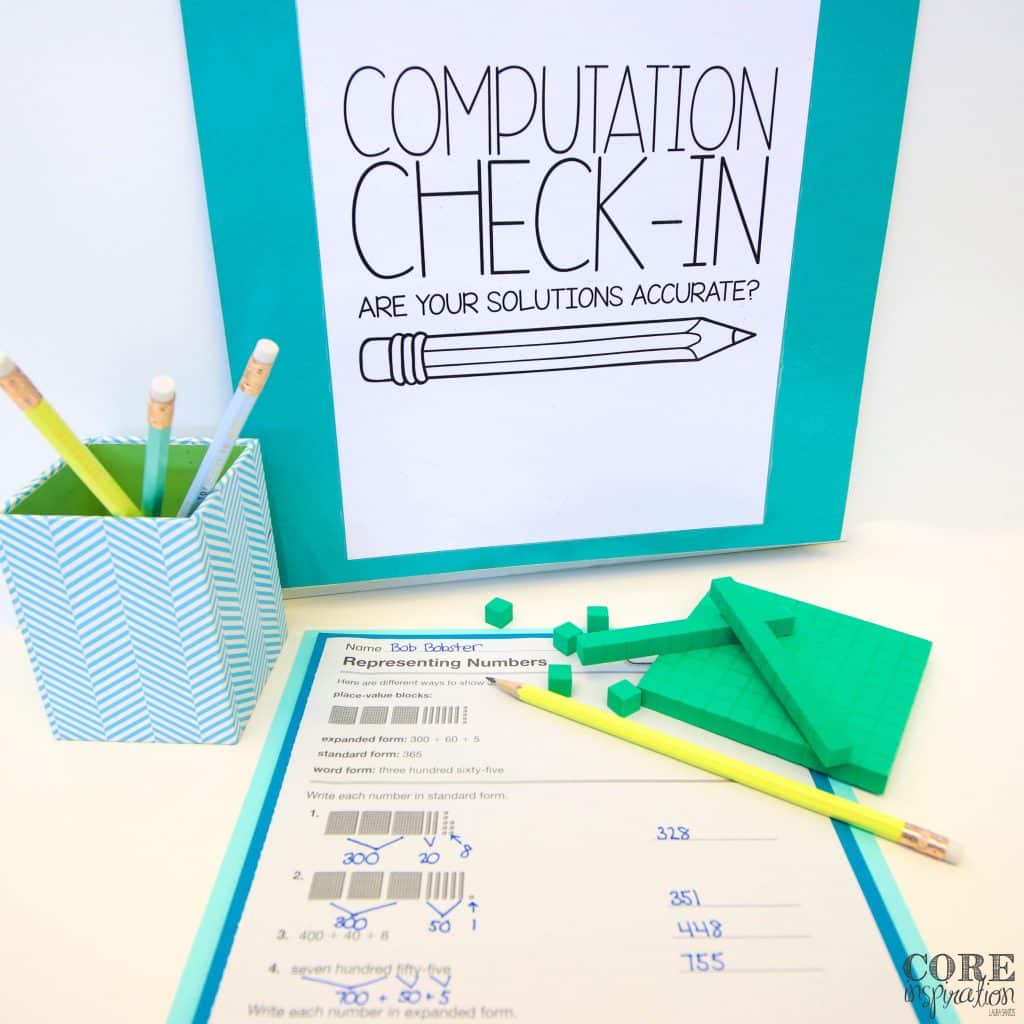
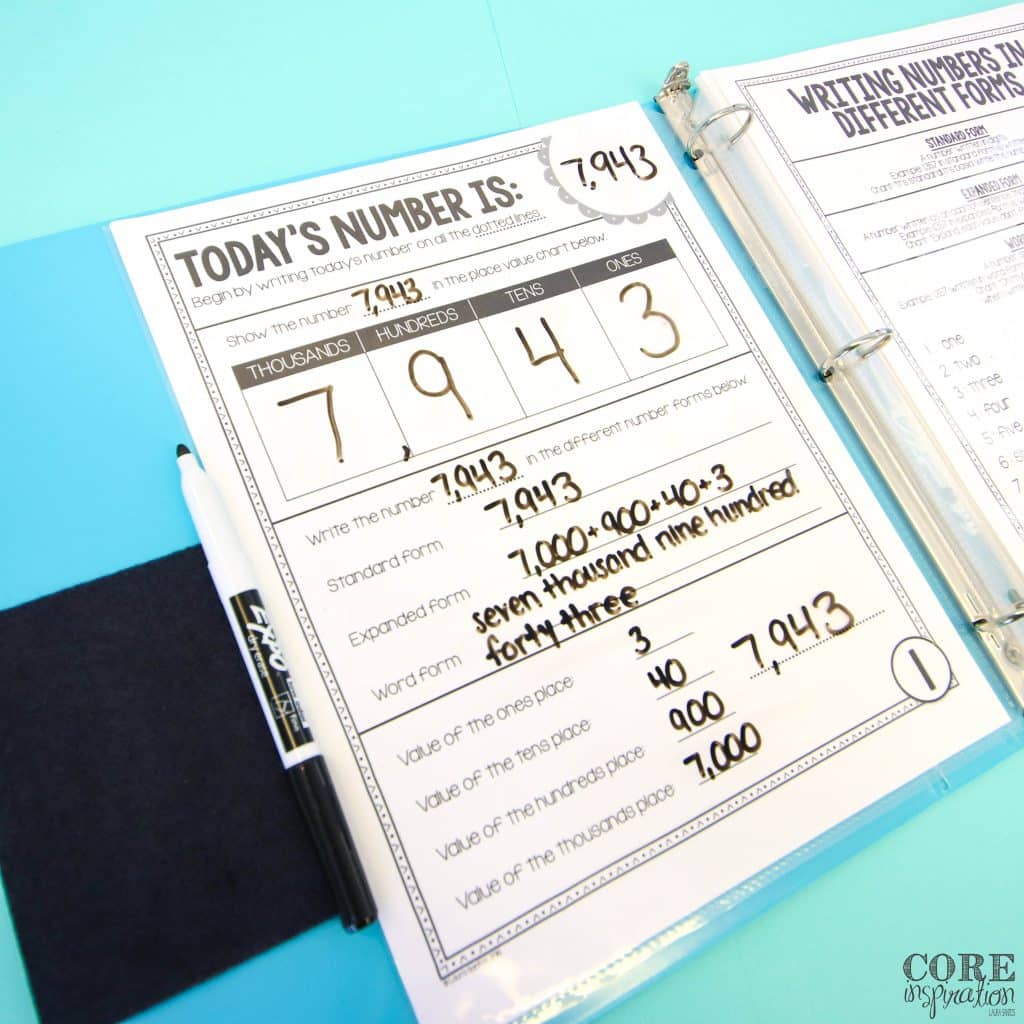
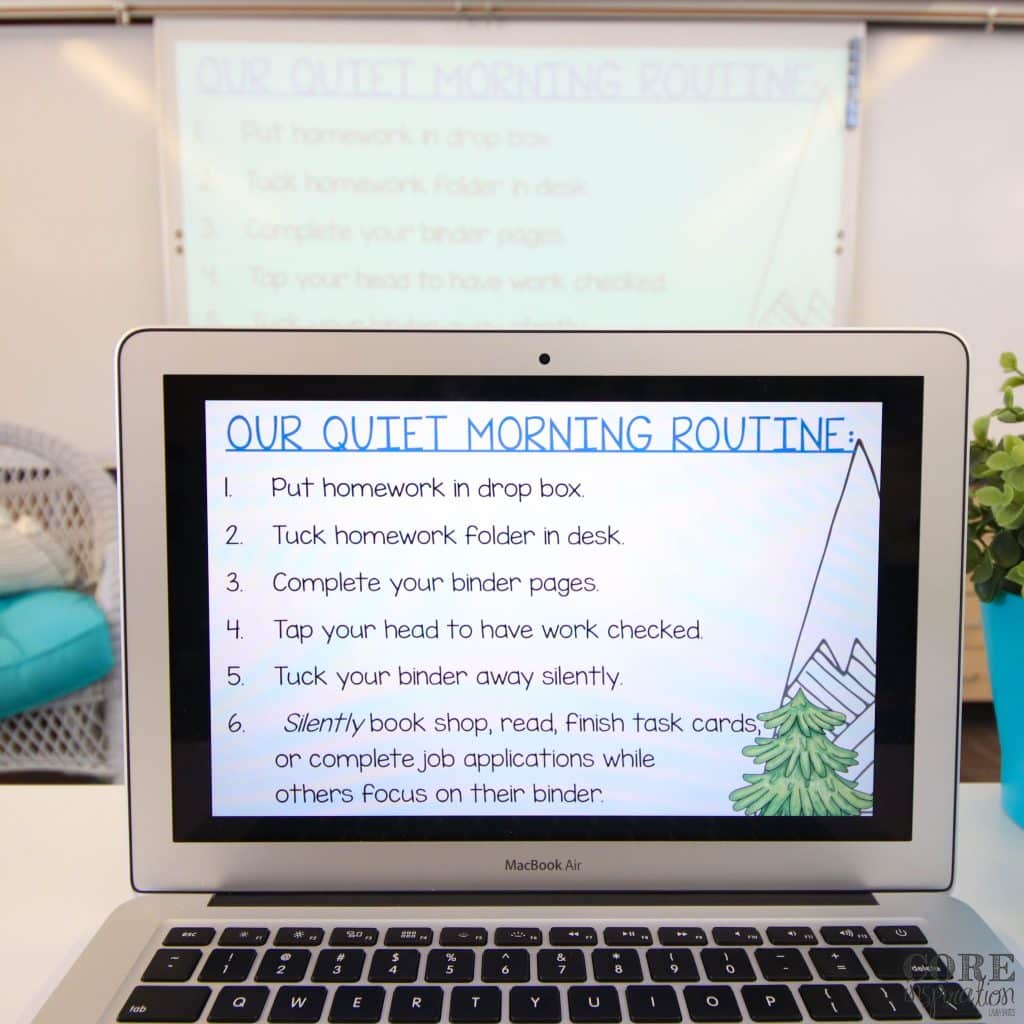
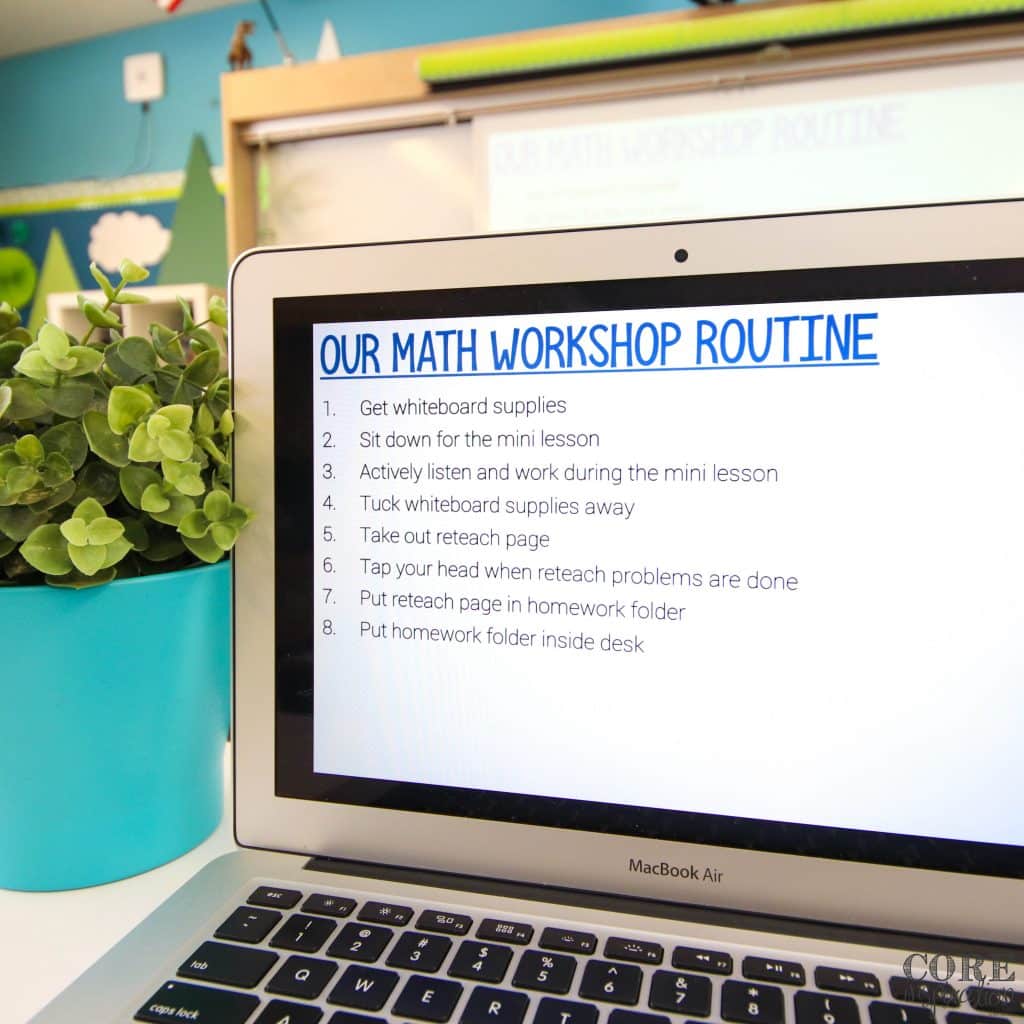
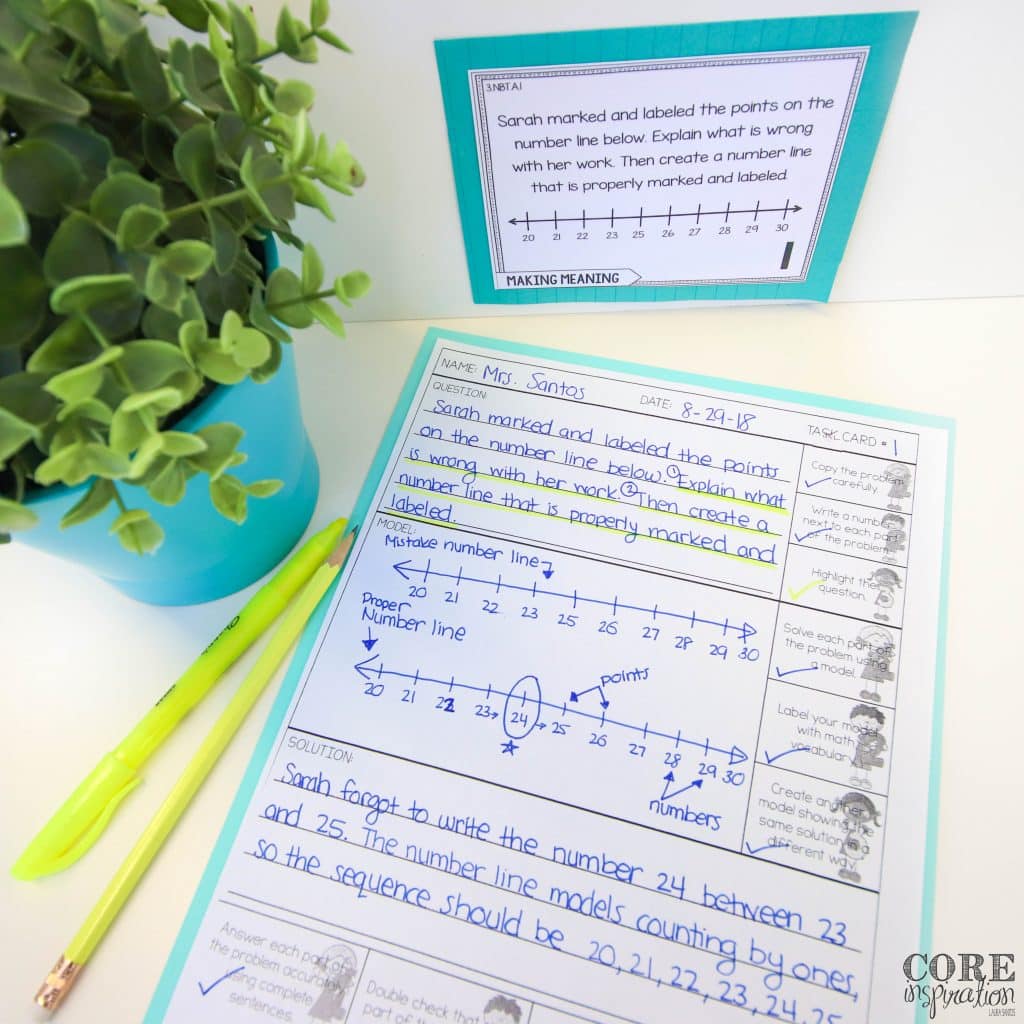
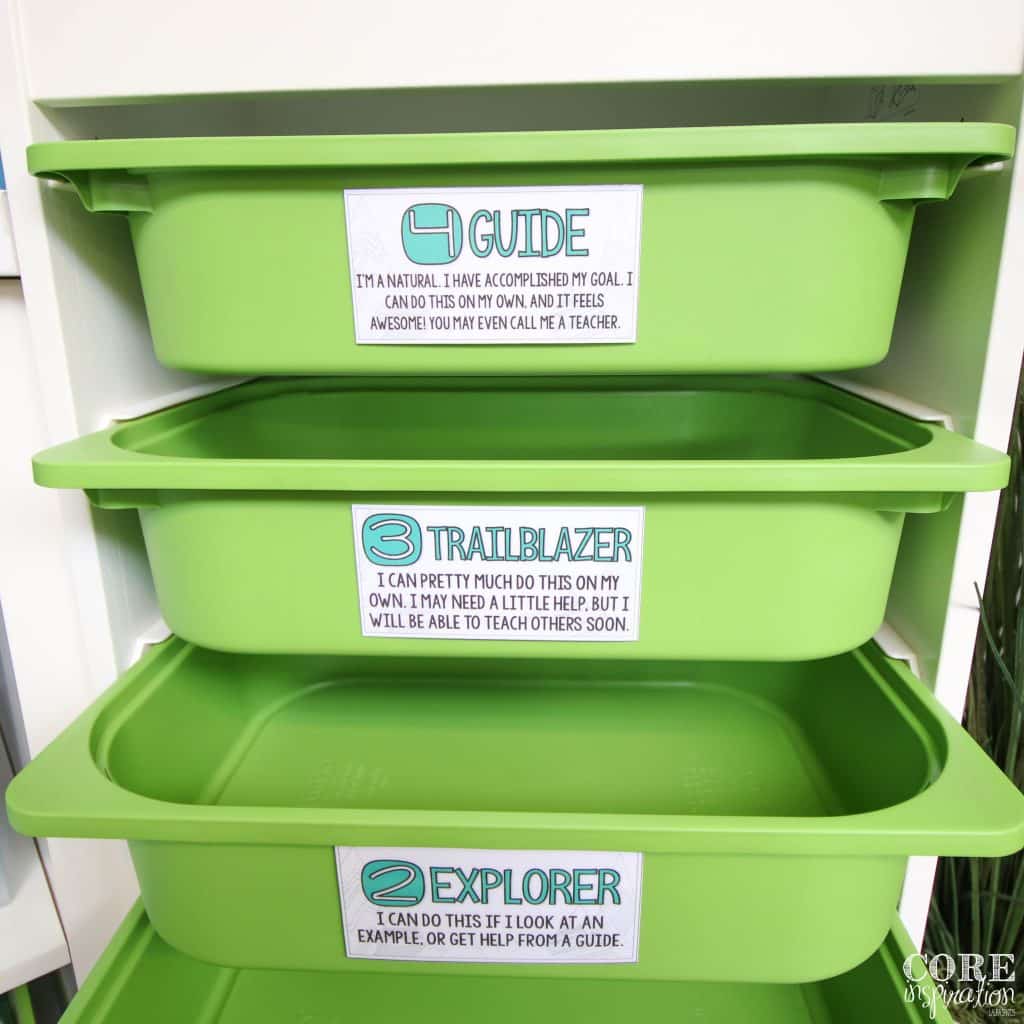

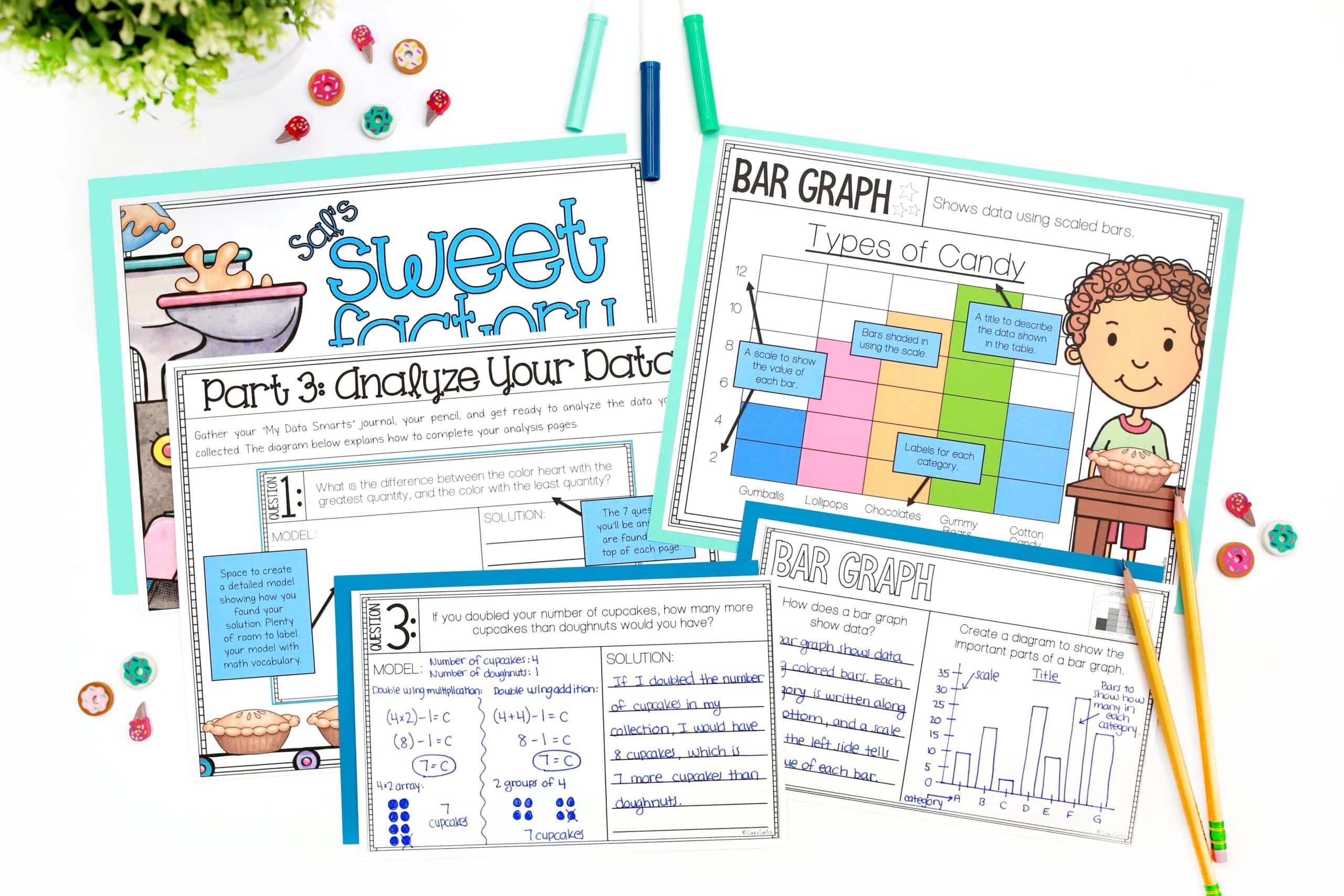
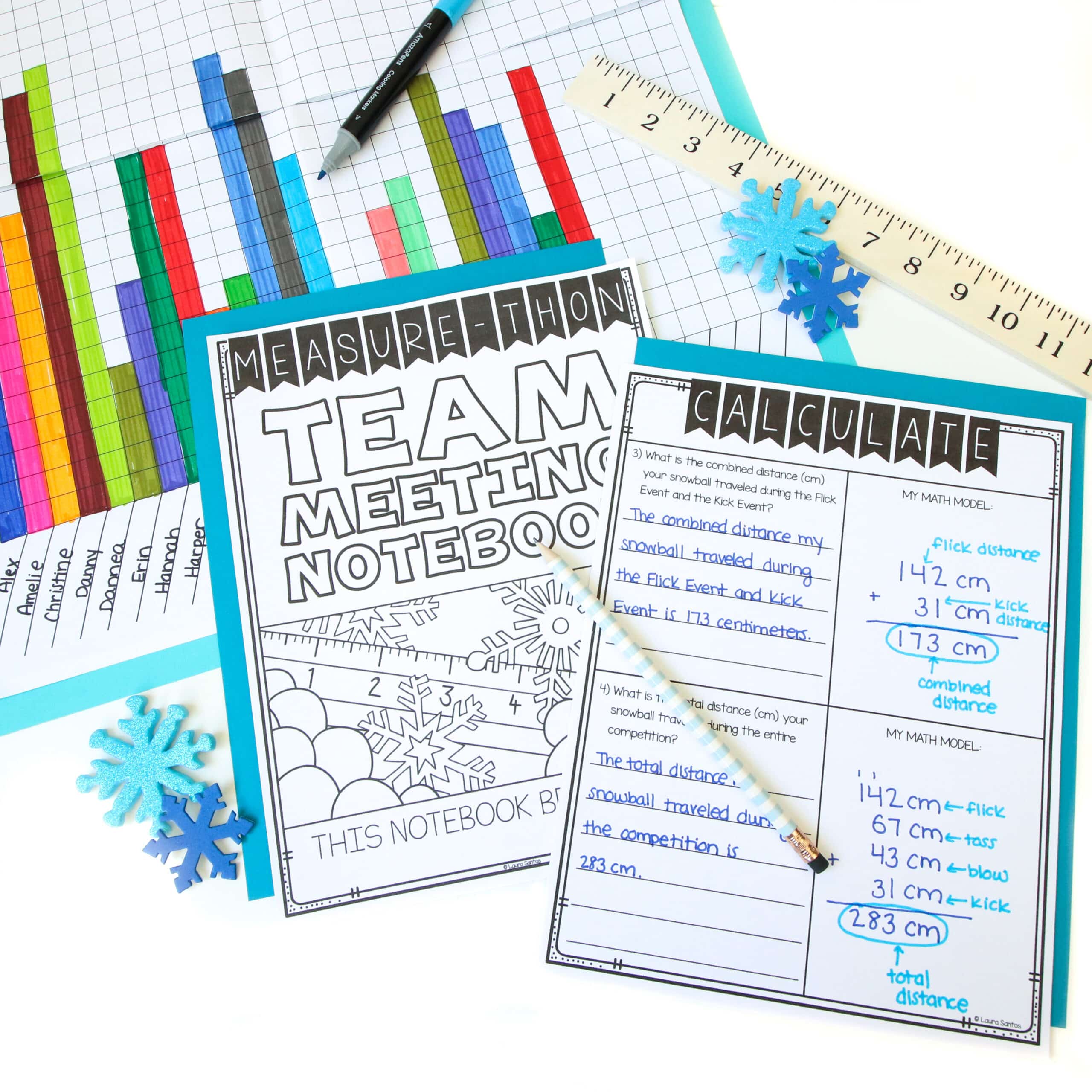

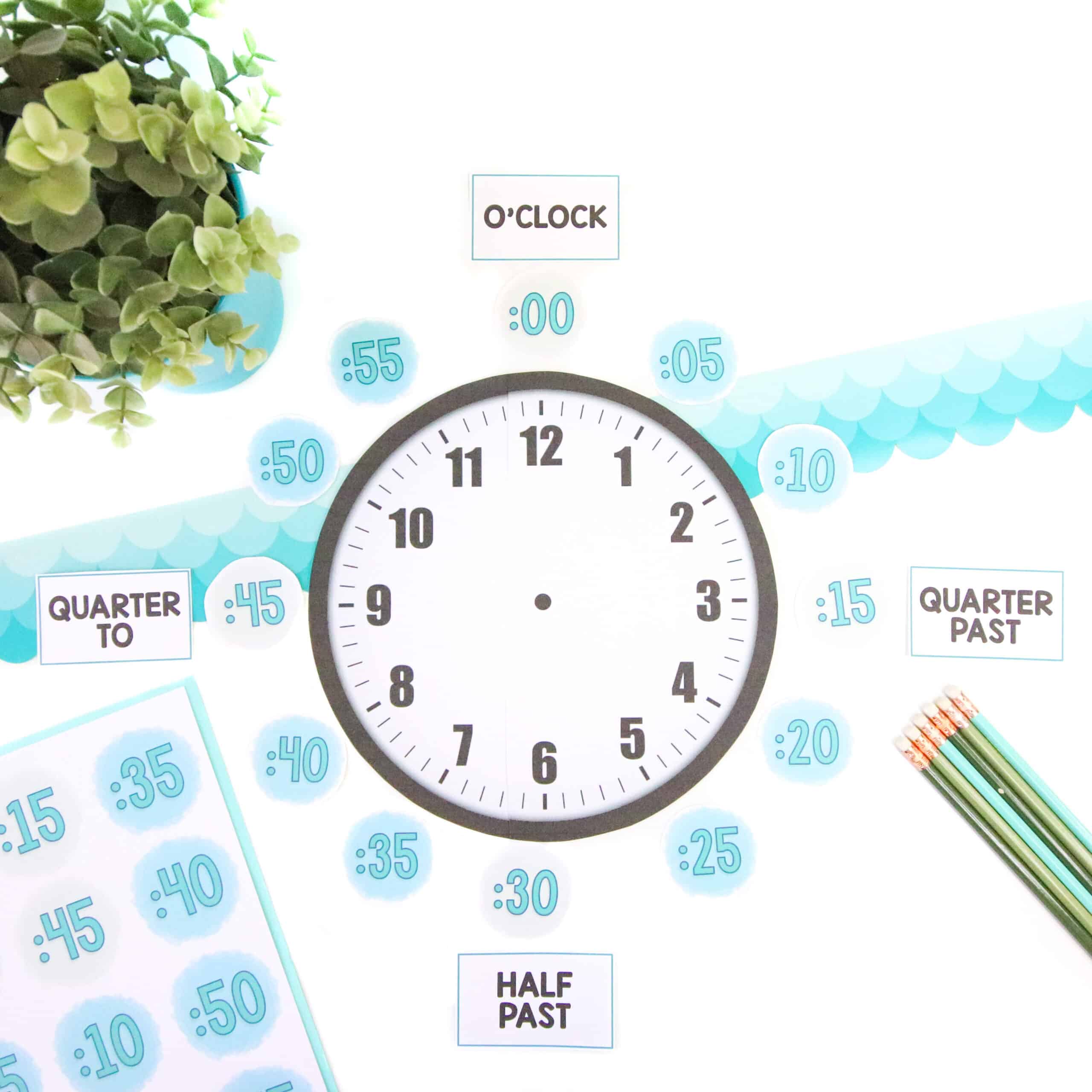
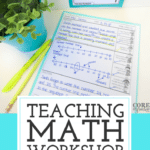
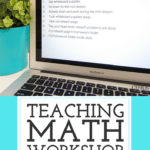
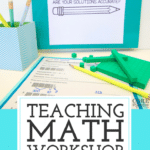
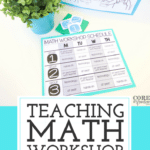

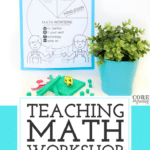
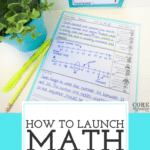
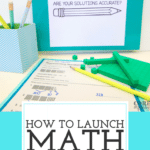
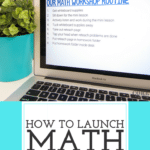
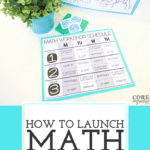
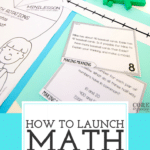
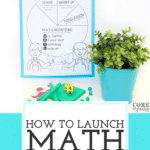
36 Responses
I am very excited to begin M.A.T.H Workshop in my first grade class. I am also using the Envisions program with my students. I wanted to know if there are task cards for 1st Grade or suggestions.
Hi Martine,
Thank you for reaching out. 🙂 I would check in with The Brown Bag teacher for first grade math task cards.
Laura
Thank you
Hi, I saw that you were using Khan Academy Tracking sheet with your class. Where can I get more information on that? Is it on your teacherspayteachers? Thanks for your help!
Hi Wendy, I do not currently have the tracking sheets available on TPT, but I appreciate you sharing your interest in them. I can add them to my project list. 🙂
Hi! I have watched your Instagram stories Over and over. Everything I have implemented has WORKED!!, thank you so much!
1.do you have plans for fourth grade math task cards….all of mine and any I have found on tpt are “scoot” type rather than word problems…
2. How many task cards are required for each week? I am trying to make my stations more fluid without timed sectiosn (I teach gifted and talented class so choice is motivating) but afraid the “games” rotation will attract the most students…any advice? I did purchase your math rotation board…
Hi Analee,
Thank you so much for taking the time to reach out with your encouraging message. I just read it aloud to my husband because you made my day. 🙂 I do not currently have math task cards for fourth grade, but I have received several requests for fourth grade tasks and I’m leaning toward taking the leap. 🙂 I require my third graders to complete two task cards per week. As for making the stations more fluid, I think it’s work a try, but I do find the gifted students within my class are highly motivated even with the structured stations because there is choice within each of those stations (i.e. several games and tasks for them to pick from). Wishing you and your students all the best!
Warmly,
Laura
How early in the year do you introduce math workshops? Like the first full week of school??
Hi Analee, thank you for reaching out. I typically wait until our third week of school. Week one is a short week with only 3 days which are all dedicated to routines and community building. The second week is a full week but there are several assessments that need to be completed so I begin on Monday of week 3.
I have 30 students and would require 4 groups in math workshop rotations. What would your suggestions be for making this model work for four groups?
Hi Christine, you can find information for grouping recommendations in this post. 🙂
Thank you for sharing all of your ideas. I loved reading about your math workshop and excited to implement with my third graders! I have two questions. I apologize if I missed these in the blog!
When you set up your math task cards do you encourage students to work on cards in numerical order? Curious how they keep track of what cards they have already completed and what task cards will be new for them while working at their seat. Also all students are to complete the worksheet from your math program before they can move on to task cards, games, tech, etc. correct? Curious if you have some students stuck on working on the math program worksheet the whole time?
Thanks again!
Hi Alli,
Thank you for reaching out. My students are welcome to complete task cards in any order they wish. They are really good about remember which tasks they’ve finished because they are so in-depth and require a good chunk of time to complete. I think since students are focused on the task for a full work session (or sometimes multiples sessions) they remember them easily. Yes my students do need to complete their workshop from our program before moving on to task cards. That sheet usually only has a quick five questions on it, so I only need to modify for some students who a slower workers. 🙂
Warmly,
Laura
Hello Laura,
I am looking to introduce MATH Workshop into my classroom this next semester. My only problem is technology. My school does not have access to technology besides our computer lab. What would you recommend to do for this rotation instead?
Hi Julia, perhaps you can make the Technology a fact fluency station instead? Perhaps you could call it “Time for Fluency” or something. 🙂 Here’s a non-tech fluency resource that might be helpful: https://www.teacherspayteachers.com/Product/Third-Grade-Multiplication-Division-Fact-Fluency-Toolkit-BUNDLE-4220316
Hi! I am really optimistic and excited for using your guided Math workshop. My district also uses Envisions so I can easily implement your practices. My question is do you use the math mats they supply in your rotations? The quick check or daily common core review? I personally feel like these are great resources, I’m just thinking of how and when to include them using M.A.T.H..
Thanks!
Thank you Cyndi! I use the Envision reteach page for the At Your Seat Rotation and the Practice page for nightly at home practice. I often use questions from the quick check as a quick exit ticket assessment when we’re closing up math workshop. Perhaps you can use the common core review page as part of the At Your Seat rotation as well. 🙂
I just left a comment on another post because I’m so thrilled by your resources, I’d LOVE task cards for fifth grade, just like Analee mentioned, I teach fifth grade and all of the task cards I found are more scoot type cards. I think I could come up some questions but if you have plans for those I’d love them. That would be so so great! I’m feeling energized about going back to school after a tough first half of the year!
Thanks!
Karla
Hi Karla, thank you for the very kind message. 🙂 Fifth grade task cards are still on my future projects list, but it’s taking me quite some time to create the fourth grade resources. I’m wondering if you’ve taken a look at task cards by Teaching With A Mountain View…her stuff is usually pretty rigorous.
Hi,
Do you have any recommendation for fourth grade task cards? I do not see them in your store. I would like to try this after spring break. I know it is late in the year but I think it will still benefit the kids as we move in to review. I am just having trouble finding task cards that are rigorous for fourth graders. Thanks!
Hi Natalie, thank you for reaching out. I do not currently have fourth grade task cards, but have them on my project list for the upcoming school year. 🙂 In the mean time, I recommend checking out the store Teaching With A Mountain View. She has some really great rigorous materials for the upper grades.
Warmly,
Laura
This post was very inciteful and helpful! I wanted to get clarification on one part. So, I understand that students are expected to submit 2 task card assignments per week. They are quickly checked. But then you said one is also placed in the bin on top for detailed feedback and placed in your gradebook. Is this assignment selected by the student after you have quickly checked them?
Also do you have these recording sheets available in your tpt store? Thanks for all you do!
Hi Rasheeda, thank you. 🙂 Yes two task cards per week. They self assess the quality of these tasks by placing them in the rubric drawers. By the end of the week, they must place the task they are most proud of in the top bin for careful grading (they make this decision independently). Here is the link to the recording sheets.
Thank you so much for all of your work posting these blogs and resources on TPT! I plan to adopt your MATH workshop this year. We will use Envision in G3 this year. My question is how much time do you actually spend in the student textbook? Also, do you check the homework each day?
You’re welcome Joshua. So excited to hear you are planning to use math workshop in your classroom this year. 🙂 My students don’t ever use the textbook. I use it when planning the problems I will include in my mini lesson, but with the games, task cards, projects, and number of the day binder, I find they get all the practice they need. When I used to use the textbook, I found my students were spending too much time answering very low-level questions/completing busy work, so I shifted the focus to a few quick problems (on the reteach page) and then have them move on to more in-depth problem solving through the task cards or projects.
I collect homework daily, and spot check the most challenging problems on the page so I know if there is anyone I need to pull for small group reteaching that day when the MATH rotations begin.
I hope these insights are helpful as you get your math block planned for the coming year!
Warmly,
Laura
I was curious about this as well. Thank you for sharing!
Hi Laura! Thanks for sharing! I see that you have a lot of recommendations of other teachers to “check-in” with, any 2nd grade teachers you recommend?
Hi Madison,
I was teaching second when I started Math Workshop so I’m happy to answer any questions or share any resources you might need. 🙂
Laura
Hi Laura,
I love all your stuff and I keep coming back to your page to learn more. I’d like to implement your quiet morning routine. I’m currently using a Power Point slide to project on my board, but I like your mountain themed one better. I’ve bought your Mountain Labels and Nametags. Is there a way I can use them to project on board to make a quiet morning routine slide? How did you make that?
Thanks!
Marlese
Hi Laura, This all looks amazing! I am implementing Math Workshop next week. My question is to what you have the kids do on Fridays…I am sorry if I missed that in these blog posts – trying to take it all in! Thank you for such a comprehensive share of this approach!
Hi Tracey, thank you! On Fridays we have several specials that take the place of our math block. Therefore, I only teach math four days a week.
Hi, Laura. I purchased your starter kit and I’m excited to begin using it with my third graders. Only trouble is that I can’t access the 3 group rotation schedule and check in and data tracking template because they are in a compressed zip file and not in a PDF acrobat document file. How can I gain access?
Hi Janel, thank you so much for supporting my TPT store. 🙂 Once you unzip the folder by double-clicking on it, all the PDFs and editable PowerPoint docs will be made available.
Warmly,
Laura
HI
I really like your blog and find lots of smart ideas. The problem I’m from Israel. All your worksheets are in English, of course, and we speak Hebrew. It’s a lot of work to translate. But I still admire your method and your friendly explanations.
This is my 2nd year as a classroom teacher and I am teaching 5th grade again this year. My goal is to use your products and information to start math small groups and increase student understanding. Do you have any task cards for 5th grade that will be coming out soon? Or challenges for 5th graders that are advanced.
Thanks!
Hi Katelyn, thank you for reaching out. I don’t have any fifth grade content coming out this year.